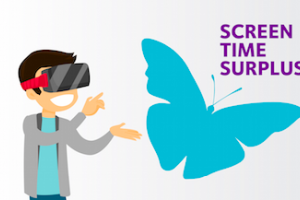
Digital devices are inextricably linked to the modern world, and it is widely accepted their daily use, which is already high, will continue to rise over time. The coronavirus pandemic has further contributed to increased use of electronics through large numbers of people studying and working from home; actions that were mandated in the early part of 2020 but continue as the preferred option for numerous communities around the world. Extended periods of digital device use are associated with symptoms of ocular and physical discomfort1-3. The disruptive nature of contact lens wear on the tear film and resulting discomfort that commonly occurs makes it extremely important to ensure the most appropriate lens technology is recommended to lens wearers who regularly use digital devices1-2. This article reviews the scale of the problem and the impact of digital devices on the eyes. Part 2 discusses the clinical performance of MyDay Energys® and Biofinity Energys® and shares advice applicable to a wide range of patients.
Widespread and growing use
Before assessing how often they are used, it is helpful to consider what the phrase ‘digital devices’ means. Desktop and laptop computers, smartphones, tablets, and e-readers all fall under the umbrella of digital devices, with wide-ranging use from work and education through to social media, TV and news content, gaming and, increasingly, video communication. When detailed like this it becomes clear how use of digital devices permeates the everyday lives of people around the world, and it is likely most individuals have access to a few of those electronics, using them for both work and leisure activities.
Increased access is illustrated by data showing a near doubling of smartphone ownership, and quadrupling of tablet ownership between 2011-2015 in the US4. By 2019, nearly three-quarters of adult Americans owned a home computer (74%) and eight out of ten had a smartphone (81%)5. In both European6, and US7 surveys it has been reported that 90% of adults use digital devices for more than two hours each day, with an average viewing time of 5.6 hours8 and 70% use two or more devices at a time7. Use is also increasing at either end of the age demographic, with over half of US children owning a smartphone by age 119. This increases to 84% ownership in teenagers (13-18 years) who spend an average of 7 hours and 22 minutes on their devices daily, not including time spent on school or homework9! Seniors or pensioners also report increasing ownership and use of electronics, with Americans over 60 years of age spending just over four hours a day on digital devices10.
The coronavirus pandemic has both increased time spent on digital devices, by around one hour extra a day, and altered what the technology is being used for, with a focus on communication and entertainment11. Initially driven by widespread global lockdown, it is expected that increased device use will continue, with one reason expressed being a preference to continue with online rather than in-person shopping12.
Digital device use symptoms
A number of terms have been used to describe the impact sustained digital device use has on the eyes. Early terminology referred to ‘computer vision syndrome’, however, in recognition of the expansion in the number of types of devices over time, ‘digital device use symptoms’ is now recommended to better reflect the variety of screens being used1. The condition is characterized by visual disturbance and/or ocular discomfort related to the use of digital devices as a result of stress on the ocular system that includes glare, defocus, accommodation dysfunction, fixation disparity, dryness, fatigue and discomfort13. It has also been defined more simply as the ocular discomfort felt after two or more hours in front of a digital screen7.
Digital device use symptoms manifests with both ocular and non-ocular symptoms. Ocular symptoms include tired eyes (asthenopia), tearing, blurred vision, burning sensations, redness and double vision. Non-ocular symptoms include headache, pain in the neck and shoulders, backache and general fatigue1,2. Some ocular symptoms result from focusing-based issues such as uncorrected refractive error, or accommodative and vergence anomalies14. Increased accommodative burden due to sustained close-up focus, accommodative demand when using multiple digital devices, and squinting in response to screen glare and font size have all been cited as contributing to the symptoms of ocular discomfort that occur13,15. Careful binocular assessment of new contact lens fits in exophoric myopes is also relevant due to their loss of base in prism effect when switching from spectacles to contact lenses13,15.
Other ocular symptoms have dry eye-related origins, resulting from a poor quality tear film, and altered blinking patterns such as a reduced blink rate
As many as 90% of digital device users experience symptoms1. A survey of more than 10,000 adults in the US found two-thirds self-reported symptoms, with increased prevalence when two or more devices were used simultaneously (73%)7. Symptoms occur commonly in children, with 80% reporting problems after sustained device use20. Working in office environments is a risk factor for visual discomfort21-23, and contact lens wearers may be more likely to suffer symptoms compared to non-wearers23. Digital device use symptoms were found to have increased during the ‘lockdown’ phase of the coronavirus pandemic in a survey of nearly 2,000 subjects in Saudi Arabia, with a reported incidence of 78%, with those who used digital devices for more than 6 hours a day at a significantly higher risk of developing more symptoms24.
A new challenge has emerged since 2020: mask-associated dry eye (MADE) occurs when the air exhaled underneath a face mask is channeled up and over the ocular surface25,26. This directional airflow increases the rate at which the tear film evaporates, leading to symptoms of dry eye. As people gradually return to shared office spaces around the world masks may need to be worn for extended periods of time. Eye care professionals (ECPs) should be vigilant in asking their patients about their ocular comfort with mask-wearing in general, and in particular if they need to be used in combination with digital devices and in air-conditioned spaces. Simple advice has been produced to help alleviate this specific situation and is available as an infographic at COVIDEyeFacts.org.
It is important to recognize the needs of contact lens wearers, with dryness and discomfort remaining the most commonly cited reasons for ceasing lens wear in adapted wearers27,28. When long hours of digital device use with resulting symptoms are factored in, it can be seen just how important it is to ensure both vision and comfort are optimized in these patients. In fact, in soft contact lens wearers who regularly use digital devices, tiredness and dryness were cited as the most common and most bothersome symptoms experienced29.







